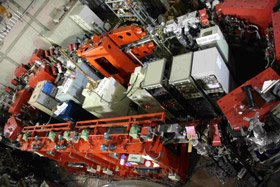Nov 16 2009
Kawakatsu Yamada and, Norihiro Sei and Hiroshi Ogawa of the Quantum Radiation Research Group, the Research Institute of Instrumentation Frontier of the National Institute of Advanced Industrial Science and Technology (AIST) have developed a compact free electron laser (FEL) that can simultaneously emit high-intensity short pulse beams of monochromatic infrared light and X-ray.
 Picture of the electron storage ring NIJI-IV for an FEL
Picture of the electron storage ring NIJI-IV for an FEL
In this study, we used an electron storage ring NIJI-IV for the FEL that was jointly developed by AIST and Kawasaki Heavy Industries, Ltd. We additionally developed an optical klystron ETLOK-III, a light source of length 3.6 m with a long undulator period and strong magnetic field, and a highly stable optical resonator system with a vibration displacement of less than 0.5 µm. By combining them, an infrared FEL is developed with a maximum output of 1.6 mW and wavelength of 0.84–1.50 µm (infrared light region).
Quasi-monochromatic X-rays are successfully generated in the optical resonator in which an infrared FEL beam collides with a bunch of electrons moving at a speed close to the speed of light. The number of generated X-ray photons is roughly 106 photons/s with the energy (equivalent to wavelength) of 1.2–2.1 MeV. It is to be noted that the realized energy range overlaps the range of 0.3–1.5 MeV where a monochromatic X-ray source has so far been believed very difficult to realize.
A prospective application of the present system would be a high-flux two-color light source of infrared light and an X-ray with variable energy (equivalent to wavelength). If applied to the accelerator such as an energy-recovery linac, one would be able to realize a quasi-monochromatic X-ray source with the energy of over 0.3 MeV and the yield of 1012 photons/s, of the level not easily attainable even in a large synchrotron radiation facility. This type of X-ray beam would offer new measuring methods for magnetic material research, and would also contribute to the development of an ultra-high density magnetic recording system.